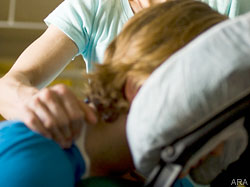
(ARA) – Oil spills, unrest overseas, a global economy that’s just starting to recover and continuing high unemployment here in the U.S. – who couldn’t use a little stress relief these days? Massage is a great way to relieve stress, but some Americans might be missing out on the therapy’s many benefits because of myths and misconceptions about massage.
“Massage can help address a wide range of physical and psychological problems, from stress to chronic pain,” says Joann MacMaster, president of Cortiva Institute — Tucson, a massage therapy school in Tucson, Ariz. “If you’ve always been interested in massage therapy, but shied away from having a massage because you thought you would be uncomfortable or that you can’t afford it, now is a great time to learn the truth.”
With demand expected to continue rising for healthcare professionals – including massage therapists – more career changers and other job seekers are pursuing massage therapy careers. There are also new and increasing opportunities for potential clients to experience massage at a price they can afford.
MacMaster, and Bobbe Bermann, Director of Education at Cortiva Institute – Chicago, offer the truth behind the top five myths about massage:
Myth No. 1 — Massage is so expensive, only the rich can afford it.
Fact: Massage therapy treatments average about $60 per hour. Many therapists, however, may offer better pricing or discounted packages for regular customers. As massage therapy gains wider acceptance in the medical community, you may also find your insurance will pay for certain types of massage. Or, you might look for a great massage therapy school that provides a student clinic, where well-trained, supervised students provide treatments at discounted prices; Cortiva offers student clinics at its locations throughout the U.S.
Myth No. 2 – You have to be undressed to get a massage.
Fact: It’s entirely up to you how much (or how little) clothing you want to remove for a massage – although tight-fitting clothing may get in the way of the treatment. Some people prefer to keep their undergarments on during a massage, while others are more comfortable completely undressed. And some treatments such as chair massage, sports, shiatsu and acupressure are usually practiced with clothes on. Whatever you decide, your therapist will make every effort to ensure you are comfortable and not embarrassed. He or she will leave the room while you disrobe or dress, will knock before entering the treatment room, and will use the sheets and draping techniques to ensure you’re properly covered at all times and only the area being worked on is exposed.
Myth No. 3 – Massage is a spa luxury and has no real medical benefits.
Fact: Far from being confined to the spa, massage is practiced in doctors’ offices, hospitals, clinics, gyms and sports centers. Massage can be a form of relaxation, but it also offers many significant health benefits, too. Recent research has shown massage can be effective in treating a range of conditions, including cancer-related fatigue and pain, lower back pain, osteoarthritis of the knee, post-operative pain, depressed immune system function, carpal tunnel syndrome, high blood pressure, frequent headache and alcohol withdrawal, according to the American Massage Therapy Association.
Myth No. 4 – Massage has to hurt to be effective.
Fact: Massage therapy does not have to be painful. While some people may favor deep tissue massage that can create some discomfort during the massage, usually therapists take great pains to ensure their clients are not uncomfortable. He or she will ask if the pressure is too deep or if the treatment is uncomfortable. And if a therapist doesn’t ask, speak up and tell her what you’re feeling.
Myth No. 5 – Anyone can call themselves a “massage therapist.”
In 2009, 42 states and the District of Columbia regulated the massage industry in some way, according to the U.S. Bureau of Labor Statistics. The requirements to be a licensed or certified massage therapist vary by state, but typically include a formal training program of 500 hours or more, covering subjects that include anatomy, physiology, kinesiology, ethics, business management and hands-on practice. Many students receive more than the minimum required hours of training; Cortiva Institute offers massage therapy programs of 600 to 1,000 hours of training.
“In addition to these top five myths about massage, you’ve probably heard more, including the idea that massage is only for women, is not widely accepted, or leaves you at the mercy of the therapist,” says MacMaster. “The truth is, massage therapy is for almost everyone, nearly a third of all adult Americans have had a massage in the past five years, and therapists are trained to help patients determine the therapy that’s best for them.”
As massage therapy continues to gain wider acceptance, and more professionals enter the field, more opportunities will arise for both the curious and the convert to experience the many benefits of massage therapy.





